National Forest Parks in China: Origin, Evolution, and Sustainable Development
Abstract
:1. Introduction
2. Methodology
2.1. Concept and Characteristics of NFPs
2.2. Development Stages and Requirement Analysis
2.3. Current Situation
2.4. Contributions and Problems Associated with the Development of NFPs
3. Results
3.1. Concept and Characteristics of NFPs
3.2. Background and Historical Pathway
3.2.1. Start-Up Stage (1980–1990): Tentative Exploration
3.2.2. Expansion Stage (1991–2000): Rapid Expansion
3.2.3. Standardization Stage (2001–2010): Regulation Formulation
3.2.4. Mature Stage (Since 2011): Optimization and Integration Development
3.3. Contents and Requirements
- Resource investigation and status analysis
- Construction scope, character and objectives
- Functional division
- Capacity prediction
- Market forecasting
- Development strategy, theme orientation and marketing plan
- Specialized planning
- Phased construction planning
- Investment-benefit analysis
3.4. Current Situation of NFPs in China
3.4.1. Number and Spatial Distribution
3.4.2. Temporal Variation
3.4.3. Spatial Variation
3.4.4. Categorization
4. Discussion: Contributions and Challenges Associated with Development of NFPs
4.1. Economic Aspect
4.2. Social Aspect
4.3. Ecological Aspect
5. Conclusions
Author Contributions
Funding
Acknowledgments
Conflicts of Interest
References
- Food and Agriculture Organization. 2015 Global Forest Resources Assessment Report. Available online: http://www.fao.org/forest-resources-assessment/zh/ (accessed on 29 June 2016).
- Chazdon, R.L.; Brancalion, P.H.S.; Laestadius, L.; Bennett-Curry, A.; Buckingham, K.; Kumar, C.; Moll-Rocek, J.; Vieira, I.C.G.; Wilson, S.J. When is a forest a forest? Forest concepts and definitions in the era of forest and landscape restoration. AMBIO 2016, 45, 538–550. [Google Scholar] [CrossRef] [Green Version]
- Naughton-Treves, L.; Holland, M.B.; Brandon, K. The role of protected areas in conserving biodiversity and sustaining local livelihoods. Annu. Rev. Environ. Resour. 2005, 30, 219–252. [Google Scholar] [CrossRef]
- Beiser-McGrath, L.F.; Huber, R.A. Assessing the relative importance of psychological and demographic factors for predicting climate and environmental attitudes. Clim. Chang. 2018, 149, 335–347. [Google Scholar] [CrossRef]
- Iranah, P.; Lal, P.; Wolde, B.T.; Burli, P. Valuing visitor access to forested areas and exploring willingness to pay for forest conservation and restoration finance: The case of small island developing state of Mauritius. J. Environ. Manag. 2018, 223, 868–877. [Google Scholar] [CrossRef] [PubMed]
- Gunter, U.; Ceddia, M.G.; Tröster, B. International ecotourism and economic development in Central America and the Caribbean. J. Sustain. Tour. 2017, 25, 43–60. [Google Scholar] [CrossRef]
- Yang, R.; Cao, Y. Discussion on the Long-term target of protected area coverage in China. Chin. Landsc. Archit. 2018, 7, 5–12. [Google Scholar]
- Buckley, R. Sustainable tourism: Research and reality. Ann. Tour. Res. 2012, 39, 528–546. [Google Scholar] [CrossRef] [Green Version]
- Sims, K.R.E. Conservation and development: Evidence from Thai protected areas. J. Environ. Econ. Manag. 2010, 60, 94–114. [Google Scholar] [CrossRef] [Green Version]
- Ochuodho, T.O.; Lantz, V.A.; Olale, E. Economic impacts of climate change considering individual, additive, and simultaneous changes in forest and agriculture sectors in Canada: A dynamic, multi-regional CGE model analysis. For. Policy Econ. 2016, 63, 43–51. [Google Scholar] [CrossRef]
- Islam, K.; Hyakumura, K. Forestland Grabbing by the Foreigners in Hokkaido, Japan: Is It a Big Concern for Sustainable Forest Development? Appl. Sci. 2018, 8, 1724. [Google Scholar] [CrossRef]
- Fu, W.; Chen, Z.; Zhu, Z.; Liu, Q.; van den Bosch, C.; Qi, J.; Wang, M.; Dang, E.; Dong, J. Spatial and Temporal Variations of Six Criteria Air Pollutants in Fujian Province, China. Int. J. Environ. Res. Public Health 2018, 15, 2846. [Google Scholar] [CrossRef]
- Feliciano, D.; Bouriaud, L.; Brahic, E.; Deuffic, P.; Dobsinska, Z.; Jarsky, V.; Lawrence, A.; Nybakk, E.; Quiroga, S.; Suarez, C.; et al. Understanding private forest owners’ conceptualisation of forest management: Evidence from a survey in seven European countries. J. Rural Stud. 2017, 54, 162–176. [Google Scholar] [CrossRef]
- Reed, M.S. Stakeholder participation for environmental management: A literature review. Biol. Conserv. 2008, 141, 2417–2431. [Google Scholar] [CrossRef]
- Lan, S.; Dai, Y.; Shen, B. Three Decades of Forest Park and Forest Tourism in China. Issues For. Econ. 2014, 2, 97–106. (In Chinese) [Google Scholar]
- Li, B.; Wu, C.; Wu, Z. The development roadmap analysis on China’s Forest Parks. Acta Ecol. Sin. 2009, 29, 2749–2756. [Google Scholar]
- Li, W.; He, B.; Qi, J.; Dong, J. Water Conservation Scenic Spots in China: Developing the Tourism Potential of Hydraulic Projects and Water Resources. Sustainability 2018, 10, 4509. [Google Scholar] [CrossRef]
- Siren, L. National Forest Park Theory and Practice; China Forestry Press: Beijing, China, 2009; pp. 5–36. [Google Scholar]
- Minyan, Z.; Xinfeng, C. Development and management of China’s national forest parks. For. Sci. 2016, 52, 118–127. [Google Scholar]
- Dongjin, L.; Hua, B. Study on the spatial structure of China’s national forest park tourist attractions. China Popul. Resour. Environ. 2016, 26, 274–277. [Google Scholar]
- Rumin, Z.; Lin, M.; Zhanhui, F.; Xiping, C. Analysis of spatiotemporal evolution characteristics and influencing factors of national forest parks in China. Resour. Dev. Mark. 2019, 25, 197–202. [Google Scholar]
- Chen, B.; Qi, X. Protest response and contingent valuation of an urban forest park in Fuzhou City, China. Urban For. Urban Green. 2018, 29, 68–76. [Google Scholar] [CrossRef]
- Fu, W.; Zhu, Z.; Chen, Z.; Huang, S.; Wang, M.; Ding, G.; Dong, J. Patterns of Variation in Atmospheric Visibility and Impacting Factors in Qiandao Lake National Forest Park, China. Sci. Silvae Sin. 2018, 54, 22–31. [Google Scholar] [CrossRef]
- Fu, W.; Chen, Z.; Zhu, Z.; Liu, Q.; Qi, J.; Dang, E.; Wang, M.; Dong, J. Long-Term Atmospheric Visibility Trends and Characteristics of 31 Provincial Capital Cities in China during 1957–2016. Atmosphere 2018, 9, 318. [Google Scholar] [CrossRef]
- Zeng, Z.X.; Zhang, A.W.; Wang, Q.T. A Research on the Problems and Solutions in the Development of the Forest Parks in China. Appl. Mech. Mater. 2013, 295–298, 2343–2346. [Google Scholar]
- Wang, G.; Innes, J.L.; Wu, S.W.; Krzyzanowski, J.; Yin, Y.; Dai, S.; Zhang, X.; Liu, S. National Park Development in China: Conservation or Commercialization? AMBIO 2012, 41, 247–261. [Google Scholar] [CrossRef]
- Miller-Rushing, A.J.; Primack, R.B.; Ma, K.; Zhou, Z. A Chinese approach to protected areas: A case study comparison with the United States. Biol. Conserv. 2017, 210, 101–112. [Google Scholar] [CrossRef]
- Master Planning of National Forest Park. 2017. Available online: http://www.forestry.gov.cn/main/3951/content-493695.html (accessed on 15 March 2017).
- Zheng, D.; Ge, Q.; Zhang, X.; He, F.; Wu, S.; Yang, Q. Regionalizaiton in China: Retrospect and prospect. Geogr. Res. 2005, 24, 330–344. [Google Scholar]
- Huang, Y.; Deng, J.; Li, J.; Zhong, Y. Visitors’ Attitudes Towards China’s National Forest Park Policy, Roles and Functions, and Appropriate Use. J. Sustain. Tour. 2008, 16, 63–84. [Google Scholar] [CrossRef]
- Li, S.; Chen, X. Study on the Developing Track of China’s Forest Parks and Forest Tourism. Tour. Trib. 2007, 5, 66–72. [Google Scholar]
- Que, C.; Huang, S.; Wu, J.; Dong, J. Construction of Evaluation System of Protected Area Based on Best-management Standard: Analysis on IUCN Green List Standards and Indicators. Chin. Landsc. Arch. 2016, 2, 83–86. [Google Scholar]
- Liu, Y. Classification system and management measures of major foreign national protected areas. Mod. Agric. Sci. Technol. 2012, 7, 224. [Google Scholar]
- Kong, S.; Zeng, S.; Yang, Y.; Chai, Z.; Yu, C.; Ma, J. Spatial differences comparison between National Nature Reserves and National Forest Park. J. Northeast Agric. Univ. 2013, 11, 56–61. [Google Scholar]
- Zhao, M.; Chen, X. The Development and Management of Forest Parks in China. Sci. Silvae Sin. 2016, 1, 118–127. [Google Scholar]
- West, P.; Igoe, J.; Brockington, D. Parks and Peoples: The Social Impact of Protected Areas. Annu. Rev. Anthropol. 2006, 35, 251–277. [Google Scholar] [CrossRef] [Green Version]
- Li, F.; Wang, X.; Liu, H.; Li, X.; Zhang, X.; Sun, Y.; Wang, Y. Does economic development improve urban greening? Evidence from 289 cities in China using spatial regression models. Environ. Monit. Assess. 2018, 190, 541. [Google Scholar] [CrossRef]
- Xu, F.; Fox, D. Modelling attitudes to nature, tourism and sustainable development in national parks: A survey of visitors in China and the UK. Tour. Manag. 2014, 45, 142–158. [Google Scholar] [CrossRef] [Green Version]
- Chen, B.; Qi, X.; Qiu, Z. Recreational use of urban forest parks: A case study in Fuzhou National Forest Park, China. J. For. Res. 2018, 23, 183–189. [Google Scholar] [CrossRef]
- Yang, L.; Li, D.; Du, L.; Han, X. Study on Temporal and Spatial Variation of Network Attention in National Park Scenic Spots A Case Study of Pan—Changjiang River Delta. Resour. Dev. Mark. 2017, 9, 1142–1146. [Google Scholar]
- Chou, W.; Tang, Y.M.; Zhang, S.Q. Study on the spatial structural evolution in national forest park of Hunan province based on aggregation and fractal. J. Cent. South Univ. For. Technol. 2016, 10, 128–133. [Google Scholar]
- Zhou, D.Q.; Edward Grumbine, R. National parks in China: Experiments with protecting nature and human livelihoods in Yunnan province, Peoples’ Republic of China (PRC). Biol. Conserv. 2011, 144, 1314–1321. [Google Scholar] [CrossRef]
- Xing, H.B.; Wang, Z.X. The impact of tourism on the local social culture. Commer. Res. 2006, 14, 162–164. [Google Scholar]
- Wu, C.C.; Wu, Z.W.; Zheng, Q.M.; Hu, W.H. A Study on the Concept of Ecotourism. Tour. Trib. 2007, 22, 69–70. [Google Scholar]
- Wu, X.; Xu, H.; Jiang, M.; Liu, L. Harmonized development in nature reserve and local community. Rural Eco-Environ. 2002, 18, 10–13. (In Chinese) [Google Scholar]
- Wang, H.W. Impacts of the New Holiday Policy on tourism behaviors of China Residents and Countermeasures for tourism. Tour. Sci. 2009, 23, 62–68. [Google Scholar]
- Zhang, C.Z. The debate and its essential on managing system of the World Heritage Site. Commer. Res. 2006, 340, 175–179. [Google Scholar]
- Kim, S.S.; Lee, C.; Klenosky, D.B. The influence of push and pull factors at Korean national parks. Tour. Manag. 2003, 24, 169–180. [Google Scholar] [CrossRef]
- Margaryan, L. Nature as a commercial setting: The case of nature-based tourism providers in Sweden. Curr. Issues Tour. 2018, 21, 1893–1911. [Google Scholar] [CrossRef]
- Vitousek, P.; D’Antonio, C.; Loope, L.; Westbrooks, R. Biological invasions as global environmental change. Am. Sci. 1996, 84, 468. [Google Scholar]
- Work Highlights for the State Forestry and Grassland Administration in 2019. Available online: http://www.forestry.gov.cn/main/5113/20190123/102852677328672.html (accessed on 22 January 2019).
- Fu, Y.; Liu, J.; Zhao, J. Review of forest policy research progress and theory frameworks. Resour. Sci. 2018, 8, 1106–1118. [Google Scholar]
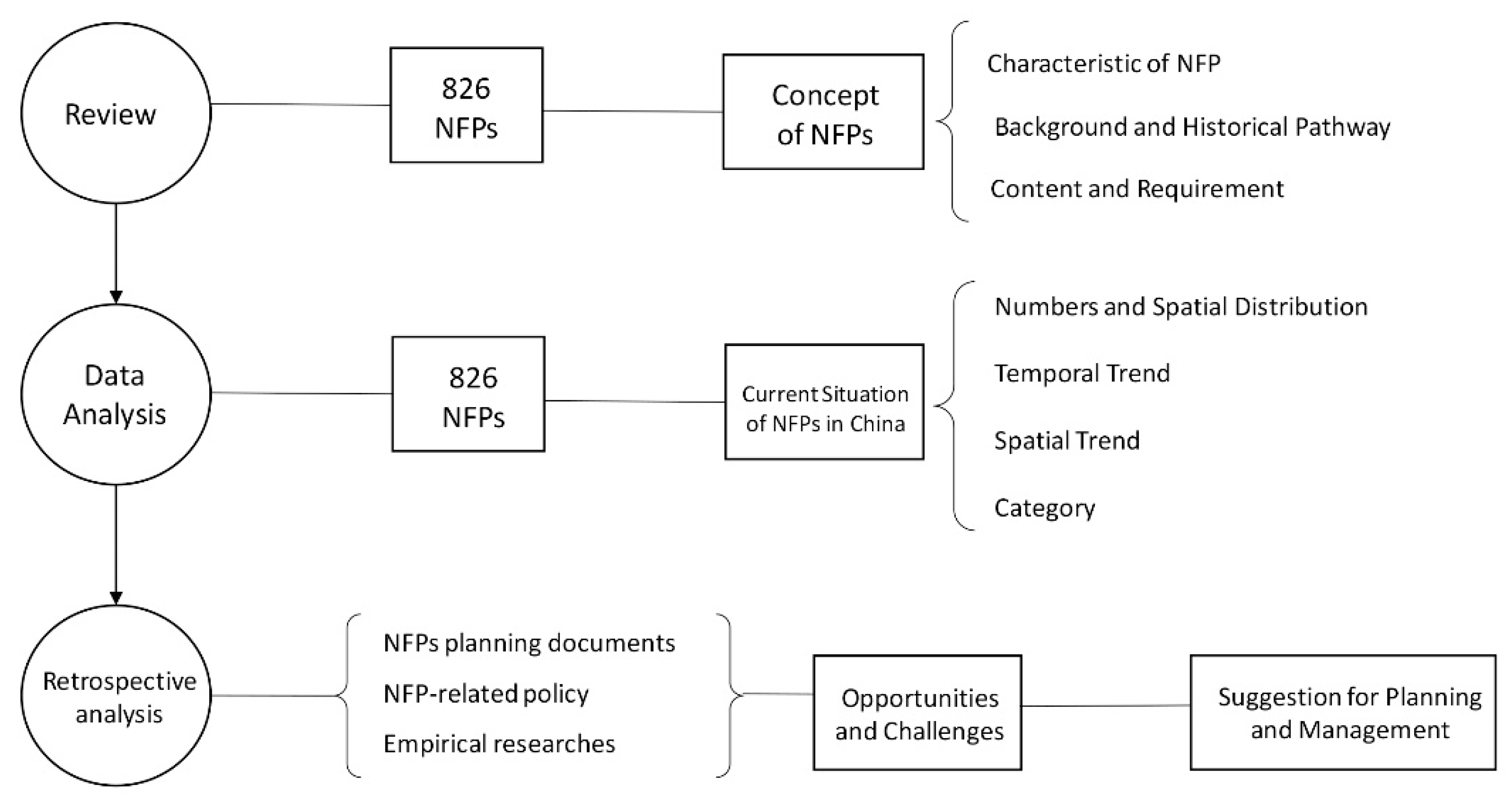
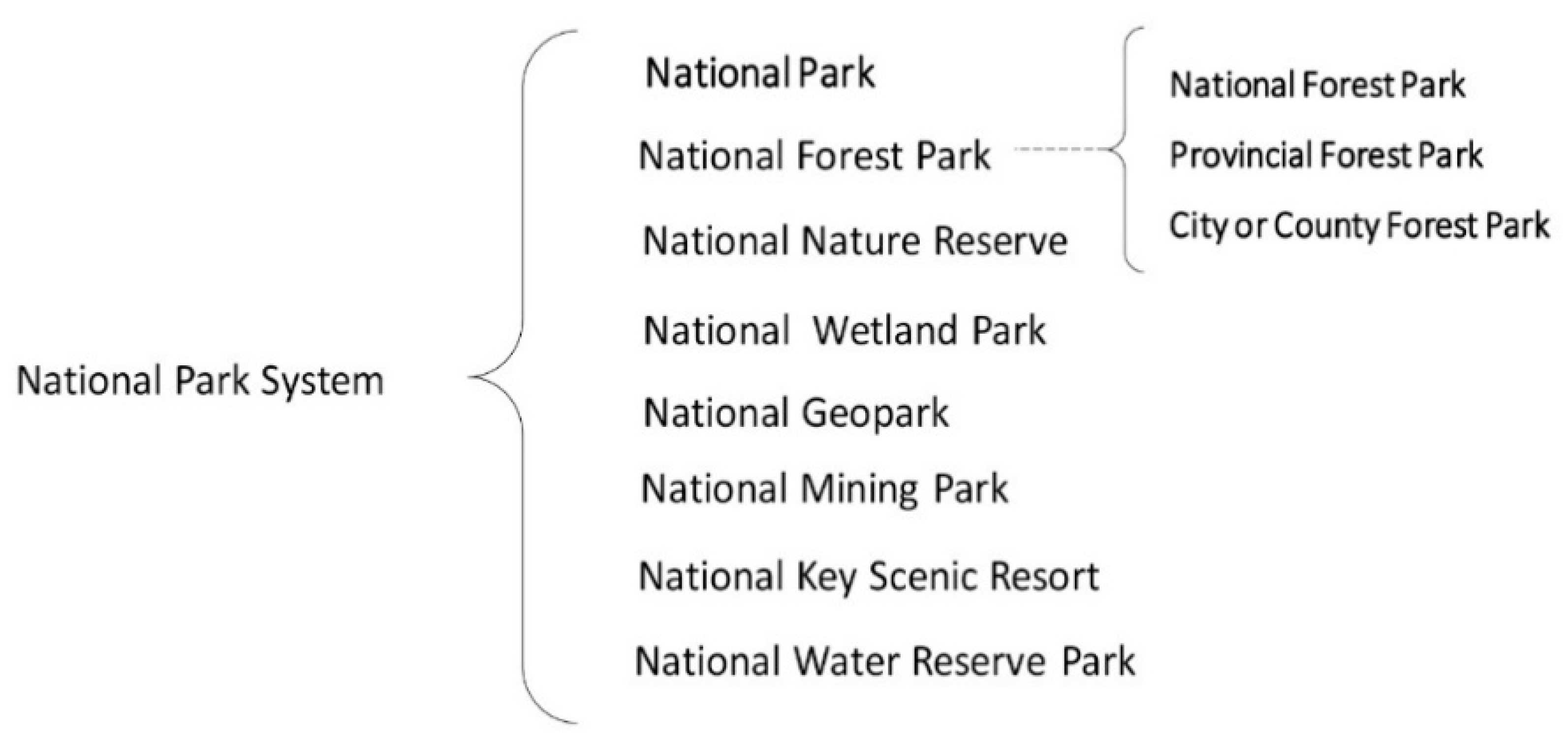
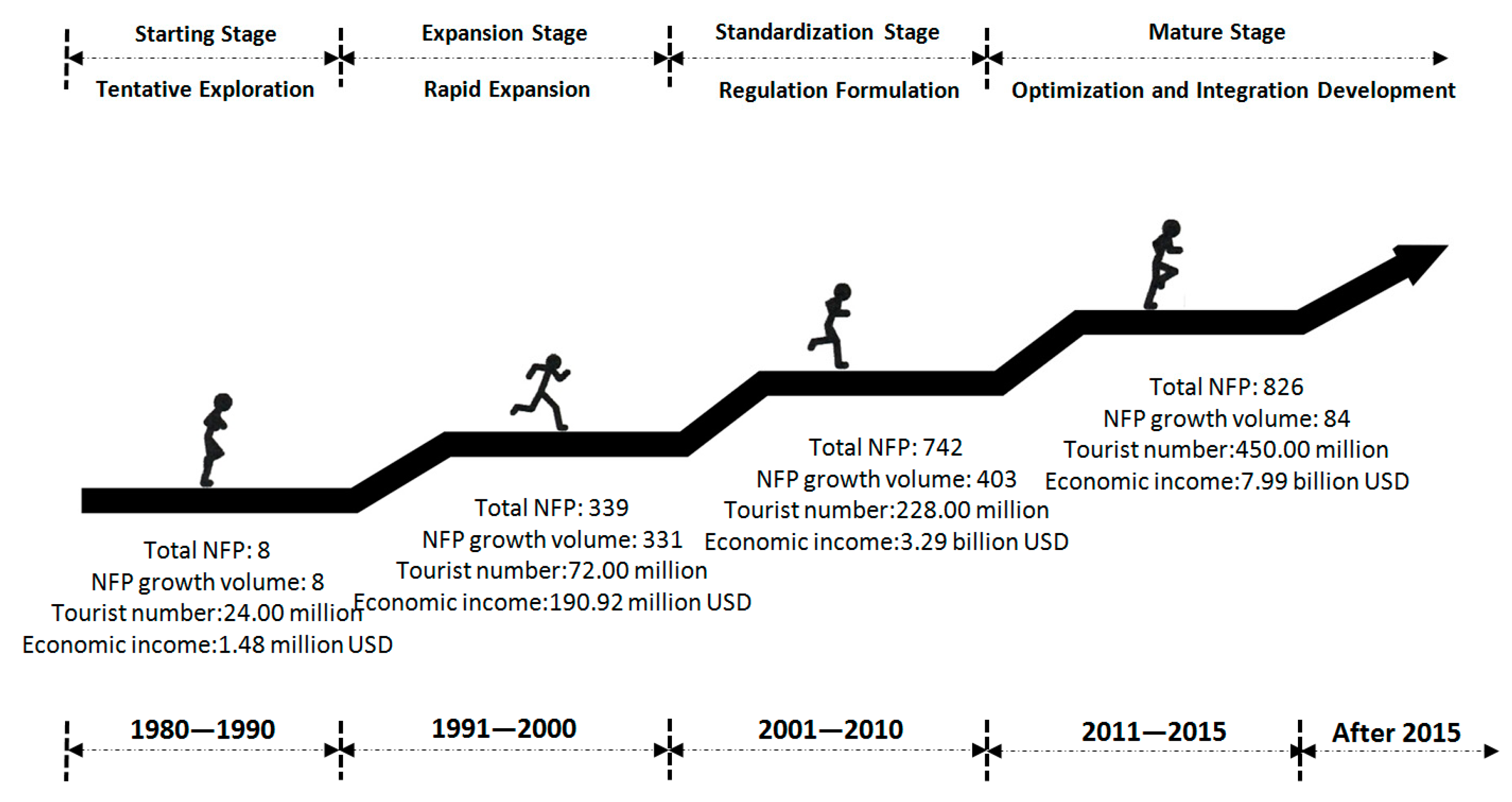
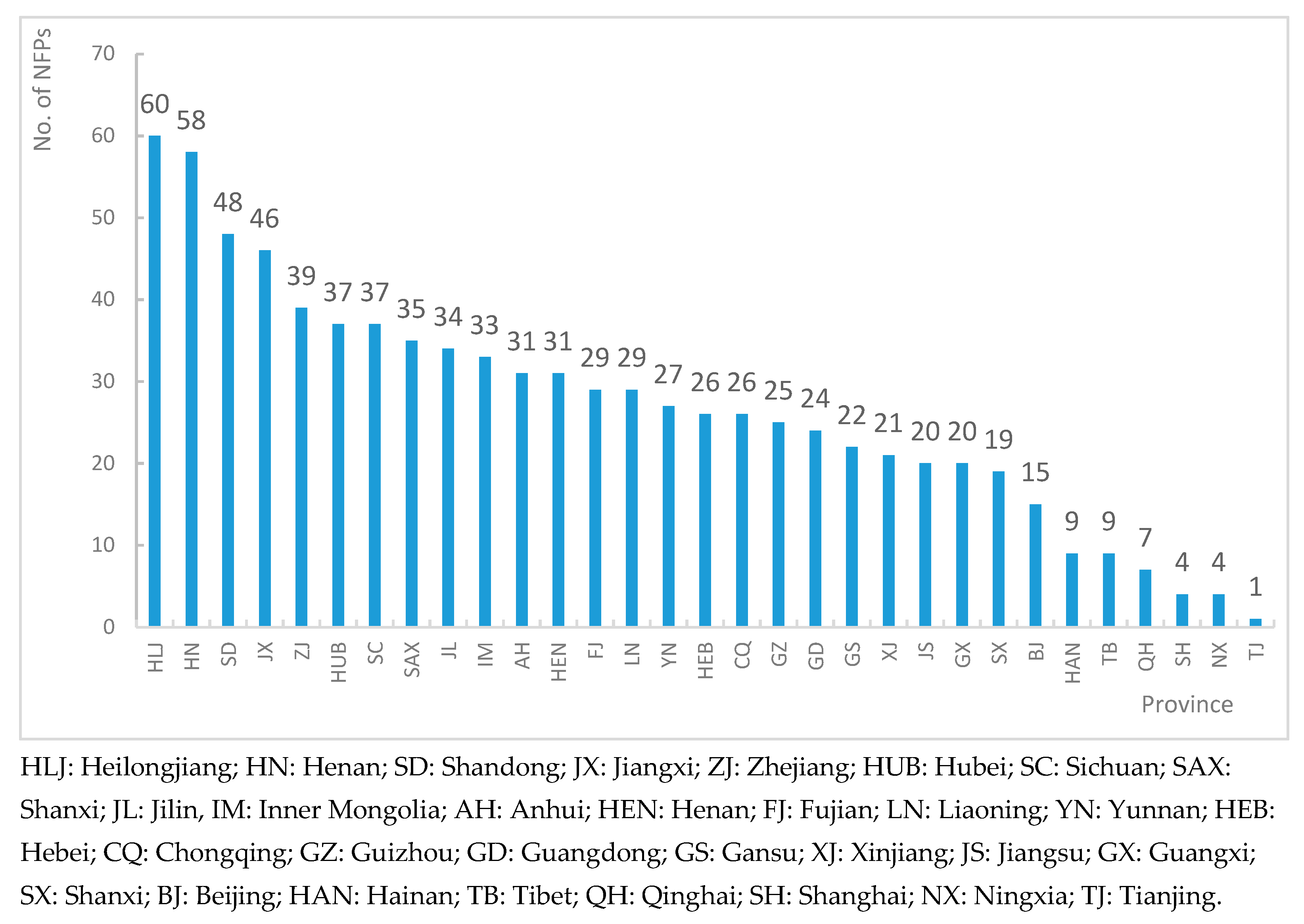
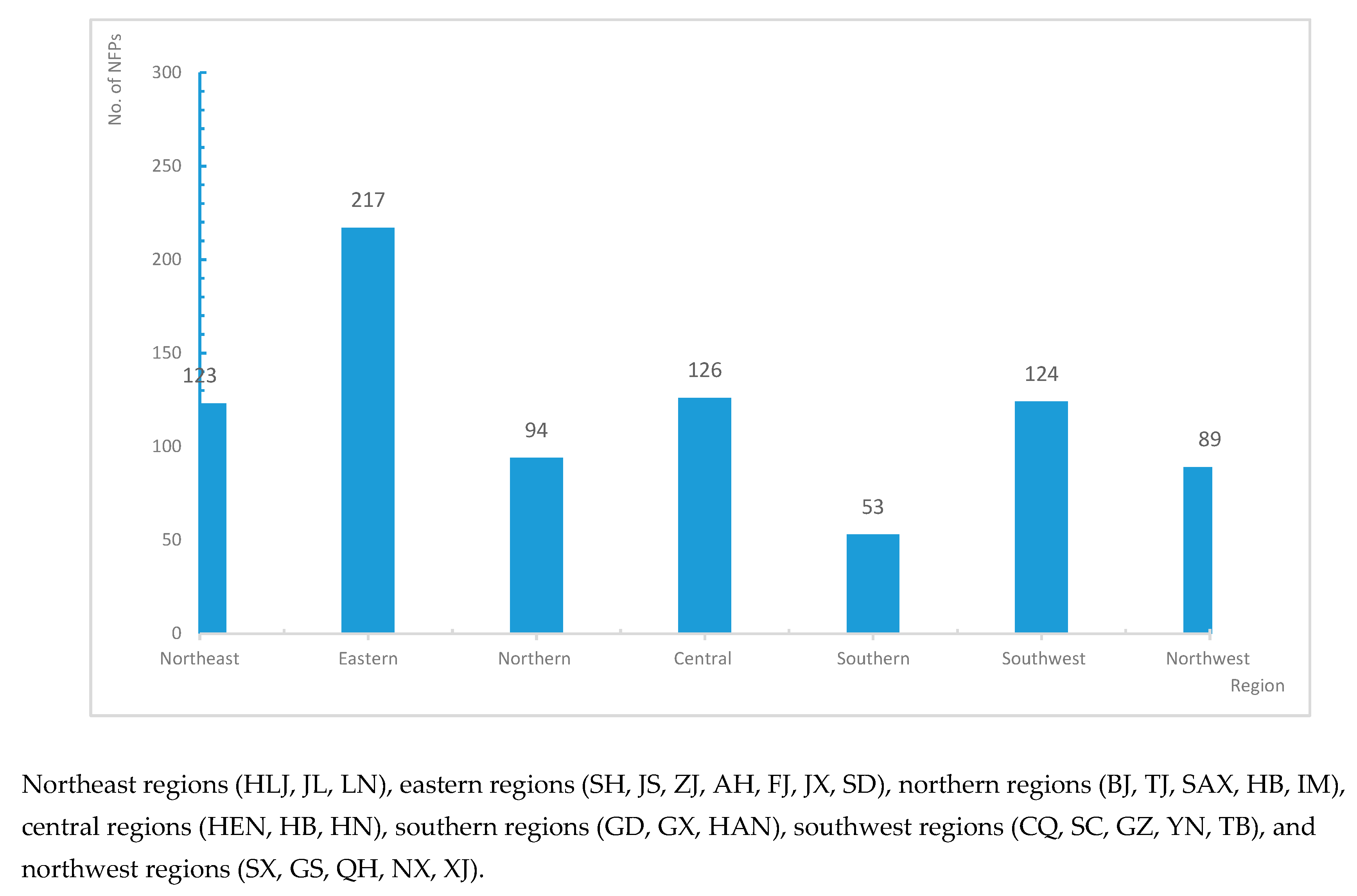
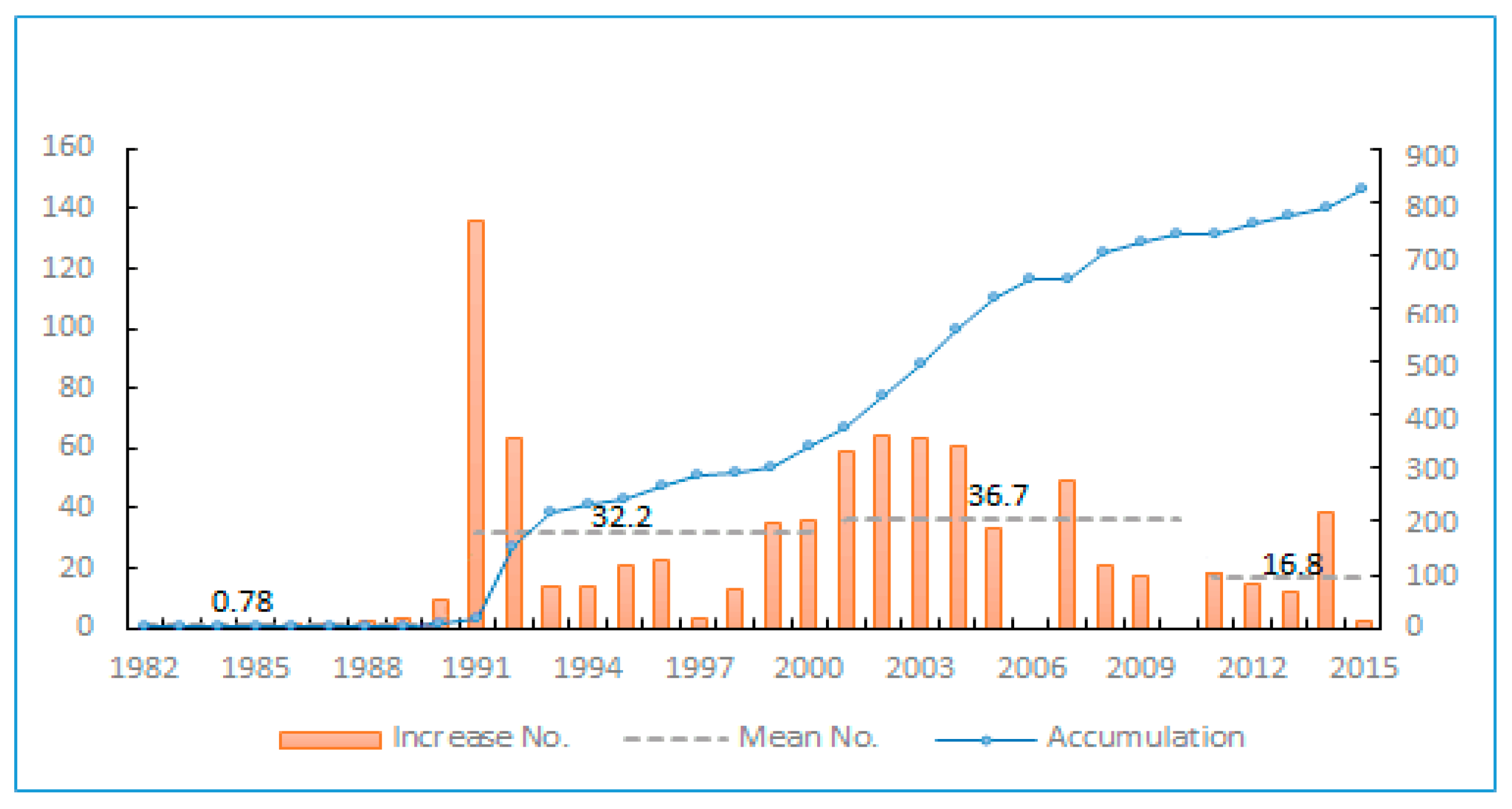
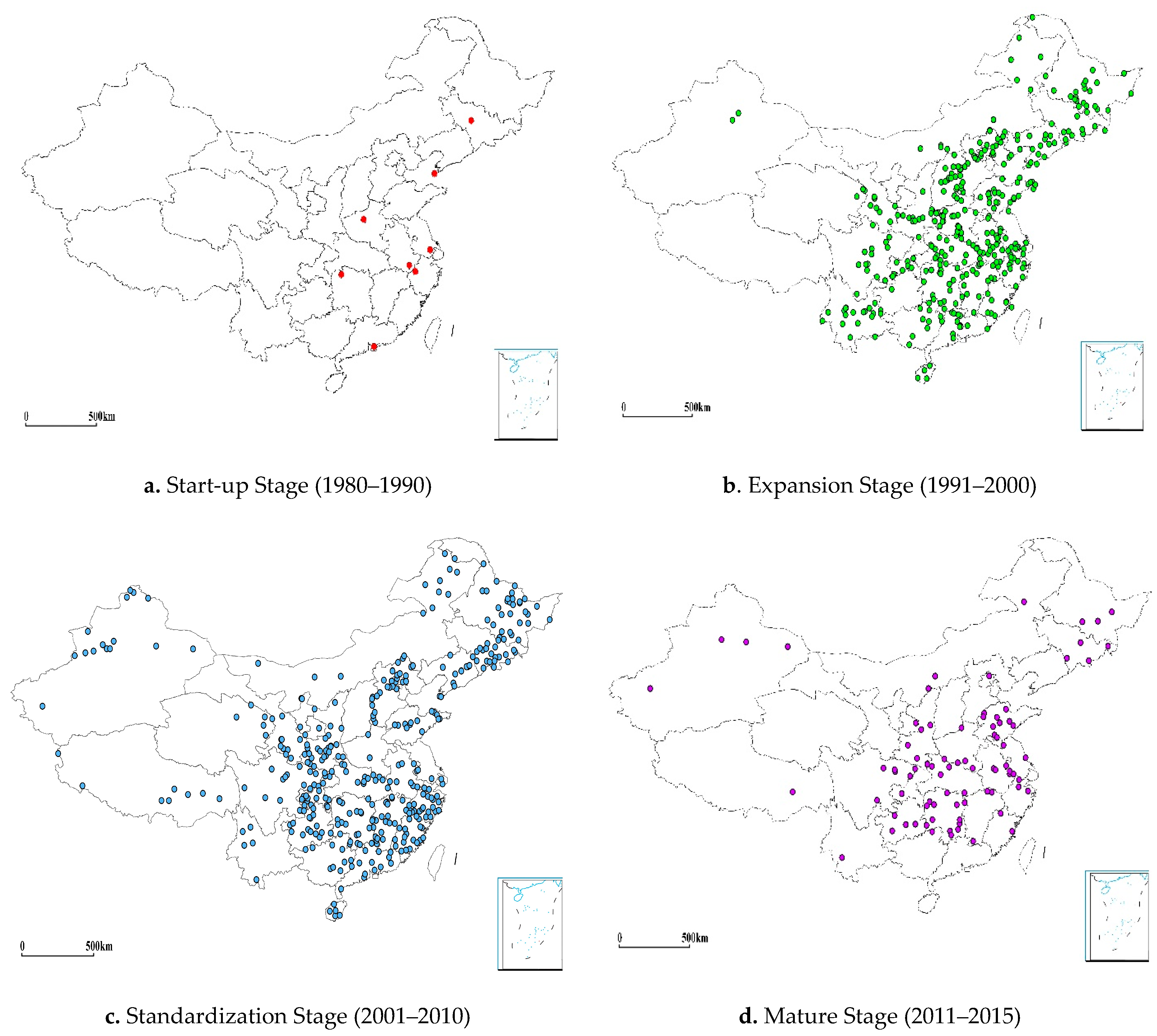
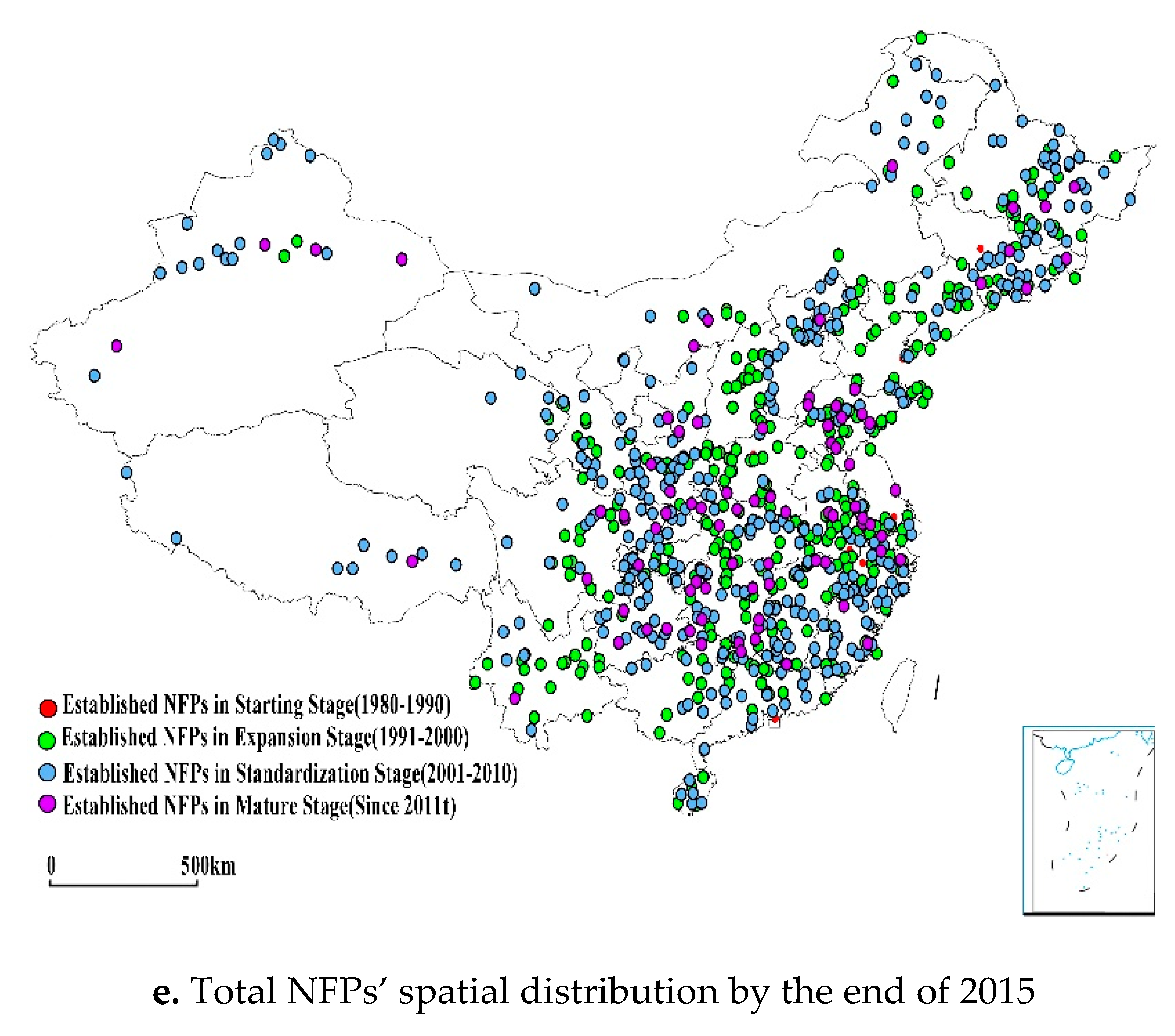

| Categories | Sub-Categories |
|---|---|
| Biological Landscape | Forest Landscape |
| Brushwood Landscape | |
| Herbaceous Landscape | |
| Rare plant Landscape | |
| Animal Resources Landscape | |
| Cultivated Vegetation Landscape | |
| Physiographic Landscape | Structural Landform |
| Rock Landscape | |
| Gravity Landform | |
| Fluvial Landform | |
| Karst Landform | |
| Lacustrine Landform | |
| Aeolian Landform | |
| Artificial Landscape | |
| Hydrological landscape | Water Landscape |
| River Landscape | |
| Deep Pools Waterfall Landscape | |
| Lake Landscape | |
| Marsh Landscape | |
| Snow Landscape | |
| Astronomical landscape | Brillouin Scattering (light phenomenon) |
| Weather and Climate Phenomena | |
| Humanistic Landscape | Construction |
| Historical Site | |
| Regional Custom |
| Item | Requirement | |
|---|---|---|
| Resource Investigation and Status Analysis |
| |
| Construction Scope, Character and Objectives |
| |
| Functional |
| |
| Capacity Prediction |
| |
| Market Forecasting |
| |
| Development Strategy, Theme Orientation, and Marketing Plan |
| |
| Specialized Planning | Conservation |
|
| Forest Landscape |
| |
| Construction of Ecological Culture |
| |
| Forest-based Ecotourism and Service Facilities |
| |
| Foundation Engineering |
| |
| Land Use |
| |
| Community Development |
| |
| Phased Construction Planning |
| |
| Investment–Benefit Analysis |
| |
| Division | Type | Representative NFP |
|---|---|---|
| Geomorphic Feature | Mountain Scenic | Zhangjiajie NFP, Taishan NFP, Huangshan NFP, Taibaishan NFP |
| Rivers or Lakes Scenic | Qiandaohu NFP, Nanwan NFP | |
| Coast-Island Scenic | Pingtan Island NFP, Qinhuangdao NFP | |
| Desert Scenic | Yulin Desert NFP, | |
| Volcanic Scenic | Aershan NFP, Huoshankou NFP | |
| Spelean Scenic | Lingyandong NFP, Shuanglongdong NFP | |
| Grassland Scenic | Huanggangliang NFP | |
| Waterfall Scenic | Qishan NFP | |
| Hot Spring Scenic | Longsheng Hot-spring NFP | |
| Travel Distance | Urban Scenic | Haerbin NFP |
| Country Scenic | Fuzhou NFP | |
| Wild Scenic | Tianshan Grand Canyon NFP | |
| Forest Ownership | Belonging to State-owned | -- |
| Belonging to Collective owned | -- | |
| Belonging to both State-owned and collective owned | -- |
© 2019 by the authors. Licensee MDPI, Basel, Switzerland. This article is an open access article distributed under the terms and conditions of the Creative Commons Attribution (CC BY) license (http://creativecommons.org/licenses/by/4.0/).
Share and Cite
Chen, Z.; Fu, W.; Konijnendijk van den Bosch, C.C.; Pan, H.; Huang, S.; Zhu, Z.; Qiao, Y.; Wang, N.; Dong, J. National Forest Parks in China: Origin, Evolution, and Sustainable Development. Forests 2019, 10, 323. https://doi.org/10.3390/f10040323
Chen Z, Fu W, Konijnendijk van den Bosch CC, Pan H, Huang S, Zhu Z, Qiao Y, Wang N, Dong J. National Forest Parks in China: Origin, Evolution, and Sustainable Development. Forests. 2019; 10(4):323. https://doi.org/10.3390/f10040323
Chicago/Turabian StyleChen, Ziru, Weicong Fu, Cecil C. Konijnendijk van den Bosch, Hui Pan, Shuping Huang, Zhipeng Zhu, Yuxuan Qiao, Nannan Wang, and Jianwen Dong. 2019. "National Forest Parks in China: Origin, Evolution, and Sustainable Development" Forests 10, no. 4: 323. https://doi.org/10.3390/f10040323
APA StyleChen, Z., Fu, W., Konijnendijk van den Bosch, C. C., Pan, H., Huang, S., Zhu, Z., Qiao, Y., Wang, N., & Dong, J. (2019). National Forest Parks in China: Origin, Evolution, and Sustainable Development. Forests, 10(4), 323. https://doi.org/10.3390/f10040323





